Fruit Packing
What do these photos tell you about how fruit packing was done?
Picking Strawberries (1910)
This is a photo of a strawberry field. The field was on the West Lake Ranch, probably in Adams County, Colorado. Many men and women are picking the strawberries. Wooden baskets held pint-size containers into which the people put the fruit as they picked it.
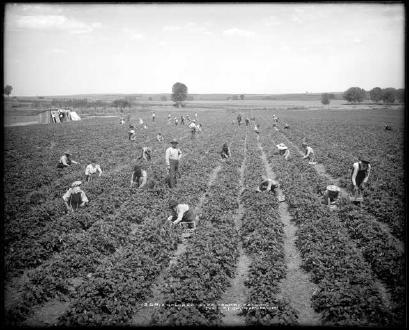
Photo: Denver Public Library, Western History Collection
More About This Topic
Notice that most of them are wearing broad-brimmed hats. Such hats kept the sun off their faces and necks. This photo was taken about 1910. Colorado localities that grew strawberries hosted festivals to advertise their fruit.
Their Own Words
“. . . About a hundred people came down from the mountains, and 260 came down on the train from the north, and between 1,600 and 1,800 people came up from Denver. . . . A large number of tables were spread, and strawberries, cream, cake, etc., were served. There was a great abundance of eatables, so that the visitors had more than they wanted. Many Boulder people were treated after the guests had been supplied.”
Source: Denver Republican, June 24, 1898, quoted in in Therese S. Westermeier, “Colorado Festivals (Part III),” Colorado Magazine, 30 (July 1953): 207.
Picking Peaches Near Clifton (1910)
This photo shows six men picking peaches. They were working on the Red Cross Ranch near Clifton, Colorado. Clifton is on the western slope of Colorado. The pickers were standing on ladders and each man had a canvas bag with straps around the men's shoulders or necks.
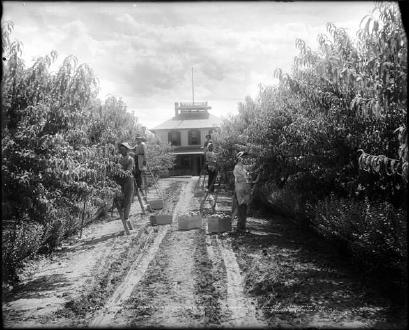
Photo: Denver Public Library, Western History Collection
More About This Topic
As they picked the fruit, they put it into the canvas bags. When the bags were full, they climbed down the ladders and emptied them into the wooden crates you see in the photo. This photo was taken about 1910.
Their Own Words
“Orchards are being planted in every direction. The tablelands or mesas . . . seem to be best for fruit. They are extremely well adapted to all kinds of deciduous fruits. The peace, apricot, and all the deciduous fruits were bearing profusely. No insect enemies were seen or heard of in this vicinity.”
Source: North Fork Times, August 1899, quoted in Wilson M. Rockwell, “The Fruit Utopia of the North Fork of the Gunnison,” Colorado Magazine, 15 (May 1938): 91.
Packing Peaches Near Palisade
This photo was taken at a peach orchard in Palisade, Colorado. The men and women in the canvas-covered shelter are packing peaches into boxes.
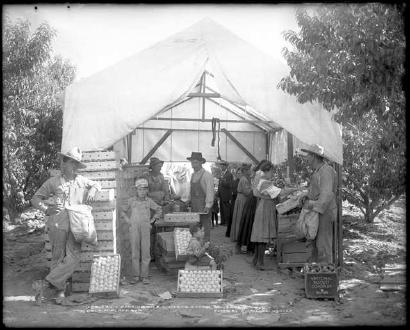
Photo: Denver Public Library, Western History Collection
More About This Topic
The fruit produced on the Western Slope mostly came from small farms of 50 to 100 acres. The farmers hired extra help during the late summer to help them pick the fruit and pack it into boxes. These peaches were being packed into boxes at the orchard.
Their Own Words
“Palisade is the peach orchard of Colorado. . . . The district is so small the little town might be compared to the office of packing house of one orchard, in which some 3,000 people find employment at this time. . . . It contains practically all of the peach crop of Colorado. It is the only section of Colorado, if not of the United States, which has never had a failure of peach crop. All fruits succeed equally well there. Pears are profitable, apples are good. . . . Peaches average the best profit, in some cases netting $1,200 to the acre. . . . Most of the orchards are from five to ten acres in size.”
Source: Grand Junction News, December 30, 1905, quoted in Mary Rait, “Development of the Peach Industry in the Colorado River Valley,” Colorado Magazine, 22 (November 1945): 250.
Fruit Packing Warehouse (1910)
This photo shows an interior view of a fruit-packing warehouse. It was in the Grand Valley, near Grand Junction, Colorado. Women workers are wrapping individual peaches and pears and then packing them in wooden crates. Can you read the names of the fruit growers on the crates?
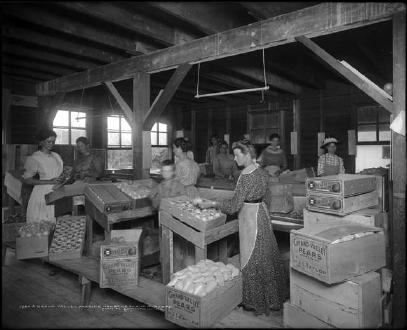
Photo: Denver Public Library, Western History Collection
More About This Topic
After the fruit was packed this way, it was shipped by Colorado Midland railroad to Denver and other places far away. This photo was taken about 1910.
Their Own Words
". . . Yesterday afternoon I went to the offices and storerooms of the Grand Junction Fruit Grower's Association, where I was shown something about the way the fruit is packed and handled. Certainly the members of the Association do know how to pack their fruit! I noticed the apples particularly. They are put up in 3 different grades--Fancy, Choice, and Standard. The Fancy apples are supposed to be perfect, though you can find certain imperfections. However, they are carefully selected and graded and very carefully packed, so that the bottom and cover bulge out about half an inch. Thus it is almost impossible for an apple to move in the box. . . ."
Source: D. W. Working to Grace Working, Grand Junction, Oct. 1, 1911; Working Papers, Colorado Historical Society.
Paonia Apple Packing Plant
This is an apple packing shed near the town of Paonia. The photo shows workers standing in front of the building. The apples were shipped out in railroad boxcars. Part of a boxcar can be seen at the left end of the building.
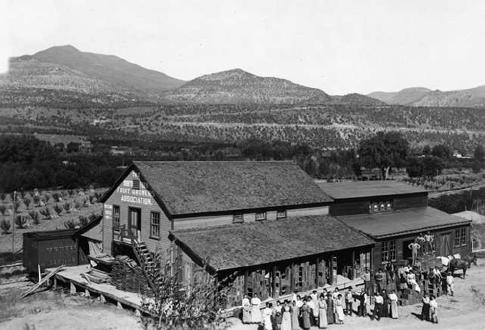
Photo: Denver Public Library, Western History Collection
More About This Topic
Apples were hauled in to packing sheds like the one in this photo. There they were graded for quality. The best apples were carefully packed in boxes to be shipped to markets across the United States.
Their Own Words
"In the [railroad] cars the boxes are laid on their sides in regular tiers. These tiers are stripped with wooden cleats reaching entirely across the car. And then another tier laid on and stripped; and so on till the car is loaded, when a strong frame is placed in the narrow alley left across the middle of the car. Thus a well-loaded car will reach the end of its journey without a single box being shaken out of its place. At the same time, the air can circulate around every box."
Source: D. W. Working to Grace Working, Grand Junction, Oct. 1, 1911; Working Papers, Colorado Historical Society.
Fruit Packing On a Red Cross Ranch
This photo shows the fruit packing warehouse on the Red Cross Ranch. This ranch was near Clifton, Colorado. Notice the mule-drawn wagons near the building. Both are packed with crates of fruit. There is another unhitched wagon inside the warehouse building. This photo was taken about 1910.
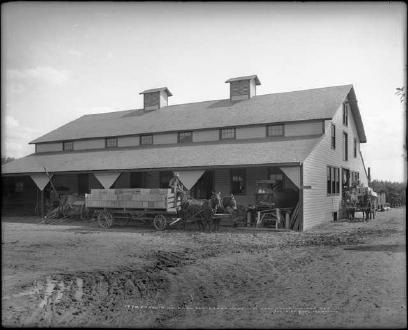
Photo: Denver Public Library, Western History Collection
More About This Topic
Fruit growing was an important part of the economy of the Western Slope. It provided a cash-crop for farmers and full-time and part-time jobs for hundreds of other people.
Their Own Words
[The Colorado Midland Railway and the Fruit Growers Association of Palisade introduced a way to advertise Palisade peaches—they introduced an annual day to distribute peaches in Denver. The day was advertised as follows.] “WANTED—5,000 people to receive the gift of 5,000 peaches—the very best on earth—at the offices of the Colorado Midland railway, at Seventeenth and California streets, Wednesday.”
Source: Denver Republican, September 15, 1908, quoted in Therese S. Westermeier, “Colorado Festivals (Part III),” Colorado Magazine, 30 (July 1953): 198.
Buying Fruit Near Westlake (1909)
This is a photo of part of a fruit-packing operation. This canvas tent was set up near West Lake Orchard in either Adams or Larimer County, Colorado. In the tent are many crates of apples.
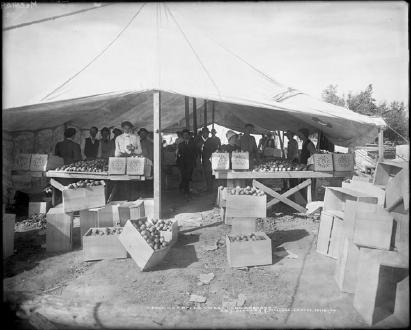
Photo: Denver Public Library, Western History Collection
More About This Topic
Because of the way that most of the people are dressed, this photo appears to show these people browsing and buying the apples. This photo was taken in October 1909.
Their Own Words
[September 16, 1891, was the first Peach Day in Grand Junction.] “’The Western Slope’ was the text which greeted the visitors’ eyes upon entrance in the building. ‘Mesa County’ appeared in raised letters over the entrance. . . . Peaches were everywhere. On the long tables were grouped 1,000 plates of peaches, each relieved with a bunch of purple grapes. At one end was a star neatly executed in peaches, at the other the new moon in the luscious golden fruit.”
Source: Denver Republican, September 16, 1891, quoted in Therese S. Westermeier, “Colorado Festivals (Part III),” Colorado Magazine, 30 (July 1953): 197.

